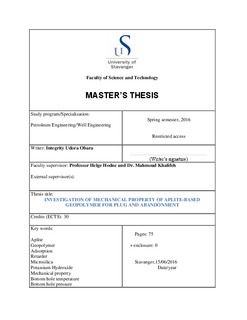| dc.contributor.advisor | Khalifeh, Mahmoud | |
| dc.contributor.advisor | Helge, Hodne | |
| dc.contributor.author | Obara, Integrity | |
| dc.contributor.editor | Helge, Hodne | |
| dc.contributor.editor | Mahmoud, Khalifeh | |
| dc.coverage.spatial | Norway | nb_NO |
| dc.date.accessioned | 2016-09-21T11:22:16Z | |
| dc.date.available | 2016-09-21T11:22:16Z | |
| dc.date.issued | 2016-06 | |
| dc.identifier.uri | http://hdl.handle.net/11250/2409240 | |
| dc.description | Master's thesis in Petroleum engineering | nb_NO |
| dc.description.abstract | Historically and up to date, ordinary Portland cement (OPC) or a slight variation is the most widely used material for permanent Plug & Abandonment operation. However, there are several challenges related to cement usage. Apart from the placement of the product and the displacement of the fluid in place which will not be considered in this work, there is also the concern of long-term sealing capability. Also cement lack adequate mechanical properties such as compressive strength and has high shrinkage, to mention just a few. Therefore, the question has always been, does there exist or is it possible to develop an alternative material that can be placed easily and can develop very high compressive strength with eternity in view and that might possibly allow for a shorter plug length.
The motivation behind this thesis experimental work is not just to develop a preferred alternative material to well plugging and abandonment, but to investigate how essential mechanical properties like compressive strength and tensile strength is developed and investigate how the mechanical integrity of aplite-based geopolymer material is impacted by compositional ratio of admixtures. Very few literature exist that discusses aplite-based geopolymer material. Therefore to extend the work done by previous researchers, we used a well-known retarder in oil well cement by applying it on the slurry design and see how it will delay the setting time. This thesis findings are of great practical importance to the drilling industry because the effect of adding additional micro silica was also investigated and reported. A scan electron microscopy (SEM) will further reveal the intermolecular counteraction of the geopolymer grain and how they contribute to strength of the material. After two months of laboratory experimental work and analysis of the results, it was discovered that sucrose addition to aplite-based geopolymer could retard the setting-time. Whereas addition of excess silica above a certain degree could prevent hardening of the geopolymer irrespective of the application of heat. | nb_NO |
| dc.language.iso | eng | nb_NO |
| dc.publisher | University of Stavanger, Norway | nb_NO |
| dc.relation.ispartofseries | Masteroppgave/UIS-TN-IPT/2016; | |
| dc.rights | Navngivelse-Ikkekommersiell-IngenBearbeidelse 3.0 Norge | * |
| dc.rights.uri | http://creativecommons.org/licenses/by-nc-nd/3.0/no/ | * |
| dc.subject | aplite | nb_NO |
| dc.subject | geopolymer | nb_NO |
| dc.subject | adsorption | nb_NO |
| dc.subject | retarder | nb_NO |
| dc.subject | microsilica | nb_NO |
| dc.subject | potassium hydroxide | nb_NO |
| dc.subject | mechanical property | nb_NO |
| dc.subject | bottom hole temperature | nb_NO |
| dc.subject | bottom hole pressure | nb_NO |
| dc.subject | petroleum engineering | nb_NO |
| dc.subject | petroleumsteknologi | nb_NO |
| dc.title | Investigation of mechanical property of aplite-based geopolymer for plug and abandonment | nb_NO |
| dc.type | Master thesis | nb_NO |
| dc.subject.nsi | VDP::Technology: 500::Rock and petroleum disciplines: 510::Petroleum engineering: 512 | nb_NO |
| dc.source.pagenumber | 76 | nb_NO |

